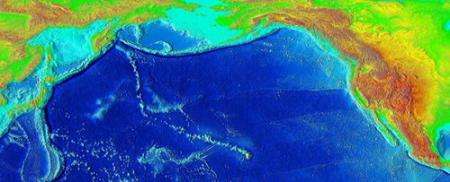Hotspots or not? Isotopes score one for traditional theory

New chemical evidence sheds light on the physical constraints of 'hotspots' -- locations where upwellings of Earth's mantle material form seamounts and island chains. Although the existence of hotspots has been debated over the past 30 years, consistent data from uranium isotope decay series at eight island locations supports the idea that concentrated plumes of hot mantle material formed these islands.
A running battle has evolved over the past 30 years concerning hotspots, with one camp claiming that it’s not necessary to invoke mantle plumes to explain such volcanic islands and a sizeable portion of the community supporting mantle plumes as the most internally consistent explanation for a wide variety of data.
A study published this week in the journal Nature raises the bar for plume opponents by finding a close correlation between modeled and observed ratios of uranium-series isotopes across eight island locations. The study strongly supports upwelling of mantle material as the source of these islands. Moreover, the detailed data allow researchers to estimate the change in temperature, speed and size of mantle plumes at the locations studied.
Alberto Saal, assistant professor of geology at Brown University, contributed data from the Ga-lapagos Islands, complementing information from researchers working in Hawaii, Pitcairn, the Azores, the Canary Islands, the Afar region, and Iceland. With such a breadth of data in hand, lead author Bernard Bourdon, professor at the Swiss Federal Institute of Technology in Zürich (formerly at the Institut de Physique du Globe in Paris), was able to build robust correlations be-tween the ratios of isotopes in the actinide series and the flux of material needed to build the ob-served islands.
“What’s exciting about this,” says Saal, “is that it allows us to make inferences about physical conditions based on chemical measurements.” While it’s impossible to visit the boundary of the mantle to make the physical measurements, it is possible to collect the chemical evidence that has been brought all the way to the surface.
When mantle rocks melt, the ratio of uranium isotopes to their decay products changes dramati-cally, then moves back to equilibrium at a steady, predictable rate. Using this change in ratios, the researchers were able to determine how quickly and completely the material melted. This also allowed them to estimate the difference in temperature between the mantle and the plumes, which determines the speed and size of the upwellings.
Beyond adding to the general evidence for mantle plumes, the study allows researchers to gener-ate some numbers that could potentially be tested. “We think we can provide some extra con-straints on these parameters that are generally poorly known,” says Bourdon.
Their estimates of temperature differences ranged between 50 and 200 degrees C with the larger differences seen in areas believed to have stronger plumes – such as Hawaii and the Galapagos. Assuming symmetrical plumes, Bourdon and his colleagues were also able to make estimates of the radius of mantle plumes at each location that roughly fit with estimates of plume diameters from seismological sources.
The more concrete researchers can make the notion of hotspots, the better chance they have to prove it right – or wrong.
Source: Brown University



















